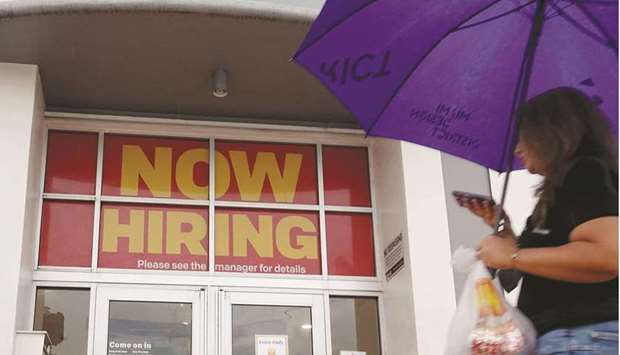The number of Americans filing new claims for unemployment benefits dropped to a 52-year low last week, suggesting economic activity was accelerating as a year marked by shortages, high inflation and an unrelenting pandemic draws to a close.
The plunge in claims reported by the Labor Department on Wednesday was, however, exaggerated by difficulties adjusting the data for seasonal fluctuations this time of the year.
Still, the labour market is tightening, with the number of people on jobless rolls the lowest since mid-March 2020 when the economy was in the grips of the first wave of Covid-19 infections.
The economy’s strengthening tone was confirmed by other data showing strong consumer spending as well as business orders for equipment, excluding transportation.
The goods trade deficit narrowed sharply last month amid a surge in exports. But higher prices remain troublesome, with inflation surging by the most in nearly 31 years.
“There might be some seasonal adjustment problems, but the handwriting is on the wall and all the anecdotal reports on how companies cannot find the help they need are true,” said Christopher Rupkey, chief economist at FWDBONDS in New York. “The economy will finish the year with a bang.” Initial claims for state unemployment benefits tumbled 71,000 to a seasonally adjusted 199,000 for the week ended November 20, the lowest level since mid-November 1969.
Economists polled by Reuters had forecast 260,000 applications for the latest week.
The decline pushed applications below their pre-pandemic average of about 220,000.
Unadjusted claims increased 18,187 to 258,622 last week amid a surge in Virginia, which offset declines in California, Kentucky and Missouri.
The report was published early because of the Thanksgiving holiday on Thursday. The data could become noisy over the holiday season.
“The claims series can be noisy and especially choppy around holidays like Thanksgiving when the seasonal factors anticipate large swings in the underlying data,” said Daniel Silver, an economist at JPMorgan in New York. “But even so, initial claims fell by more than a half mn over the year through Nov.
20, both before and after seasonal adjustment.”
Claims have declined from a record high of 6.149mn in early April 2020, and are now in a zone viewed as consistent with a healthy labour market, though an acute shortage of labour caused by the pandemic is hindering faster job growth.
But there is hope for an increase in the labour pool.
The number of people continuing to receive benefits after an initial week of aid dropped 60,000 to 2.049mn in the week ended Nov.
13, the claims report showed.
That was the lowest level since the mid-March in 2020.
Employment growth has averaged 582,000 jobs per month this year.
There were 10.4mn job openings as of the end of September.
The workforce is down 3mn people from its pre-pandemic level, even as generous federal government-funded benefits have expired, schools have reopened for in-person learning and companies are raising wages.
Stocks in Wall Street were trading lower. The dollar rose against a basket of currencies.
US Treasury prices were mixed.
The claims data was bolstered by reports on October consumer spending and business investment in equipment in suggesting the economy was regaining speed in the fourth quarter after hitting a speed bump in the July-September period as coronavirus cases flared up over the summer and shortages became more widespread.
A separate report from the Commerce Department on Wednesday confirmed the sharp slowdown in growth in the third quarter.
Gross domestic product increased at a 2.1% annualised rate, the government said in its second estimate of GDP growth for the period.
That was still the slowest growth pace in more than a year but was revised slightly up from the 2.0% pace of expansion reported in October.
The economy grew at a 6.7% rate in the second quarter.
The slight upward revision last quarter reflected a more moderate pace of inventory drawdown than initially estimated, which offset a big step-down in consumer spending.
But that is all in the rear-view mirror. A third report from the Commerce Department showed consumer spending, which accounts for more than two-thirds of US economic activity, jumped 1.3% in October after rising 0.6% in September.
Consumers bought motor vehicles and travelled, showing no signs yet of holding back because of high inflation.
Global economies’ simultaneous recovery from the pandemic, fuelled by trillions of dollars in relief money from governments, has strained supply chains, unleashing inflation.
President Joe Biden announced on Tuesday that the United States would release 50mn barrels of crude from the US Strategic Petroleum Reserve to help cool oil prices, in coordination with China, India, South Korea, Japan and Britain.
The personal consumption expenditures (PCE) price index, excluding the volatile food and energy components, increased 0.4% last month after gaining 0.2% in September.
In the 12 months through October, the so-called core PCE price index accelerated 4.1%. That was the largest gain since January 1991 and followed a 3.7% year-on-year advance in September.
The core PCE price index is the Federal Reserve’s preferred inflation measure for its flexible 2% target.
Adjusted for inflation, consumer spending rose a solid 0.7%.
In another boost to the economy, orders for non-defence capital goods excluding aircraft, a closely watched proxy for business spending plans, rose 0.6% last month, the Commerce Department said in a fourth report.
More goods were exported in October, helping to sharply narrow the goods trade deficit by 14.6% to $82.9bn.
If the trend holds, trade could contribute to GDP growth in the fourth quarter.
Wholesalers continued to rebuild inventories last month though motor vehicle shortages stymied progress by retailers, a fifth report showed.
Inventory accumulation, the key driver of GDP growth last quarter, will likely continue to support the economy in the fourth quarter.

A ‘Now Hiring’ sign hanging above the entrance to a McDonald’s restaurant in Miami Beach, Florida. In a milestone in the US economy’s recovery from the pandemic, the US government said yesterday that new claims for unemployment benefits have fallen below their level before Covid-19 struck and caused mass layoffs.


